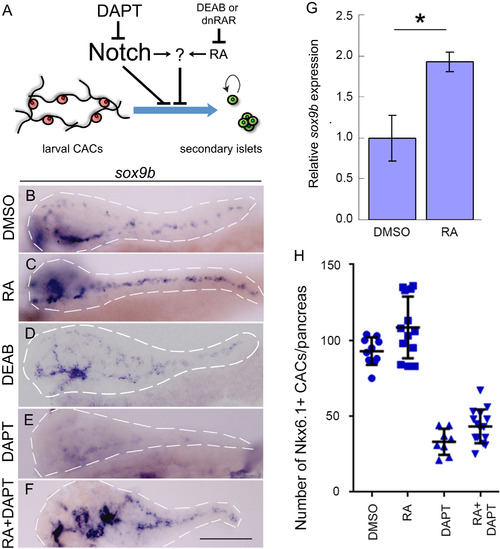Fig. 1
- ID
- ZDB-FIG-161027-1
- Publication
- Huang et al., 2016 - Sox9b is a mediator of retinoic acid signaling restricting endocrine progenitor differentiation
- Other Figures
- All Figure Page
- Back to All Figure Page
|
RA and Notch signaling both influence larval CAC expression of sox9b. (A) Model of the regulation controlling larval CAC differentiation towards an endocrine fate. Notch signaling blocks differentiation that can be overcome by the Notch-inhibitor, DAPT. RA also impedes differentiation, an action that can be inhibited either by blocking RA synthesis with diethylaminobenzaldehyde (DEAB) or signal transduction with a dominant negative RA receptor (dnRAR). DAPT and DEAB work synergistically to inhibit CAC differentiation, suggesting a shared mechanism downstream of Notch and RA signaling ( Huang et al., 2014). (B-F) Images of dissected larval foregut following whole mount in situ hybridization to detect sox9b expression. Larvae were treated from 3 to 5 dpf with DMSO (B), RA (C), DEAB (D), DAPT (E) or RA+DAPT (F). White dashed lines outline pancreata. Scale bar=100 Ám (F). (G) Quantitative RT-PCR results indicate that sox9b expression is significantly increased in dissected larval pancreata following RA treatment from 4 to 5 dpf; t-test *p<0.01. (H) Quantification of the number of Nkx6.1+ CACs in larval pancreata at 5 dpf after drug treatment from 3 to 5 dpf. Error bars indicate SD. |
| Gene: | |
|---|---|
| Fish: | |
| Conditions: | |
| Anatomical Term: | |
| Stage: | Day 5 |
| Fish: | |
|---|---|
| Conditions: | |
| Observed In: | |
| Stage: | Day 5 |
Reprinted from Developmental Biology, 418(1), Huang, W., Beer, R.L., Delaspre, F., Wang, G., Edelman, H.E., Park, H., Azuma, M., Parsons, M.J., Sox9b is a mediator of retinoic acid signaling restricting endocrine progenitor differentiation, 28-39, Copyright (2016) with permission from Elsevier. Full text @ Dev. Biol.

